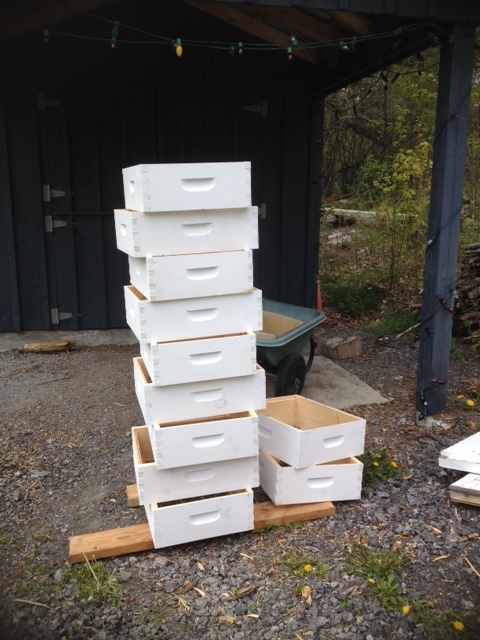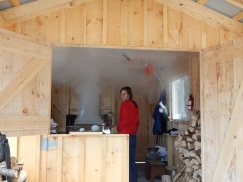An interesting conversation I had with the head beekeeper of the Ottawa Community Beekeepers Association stands out in my head. He told me to always be thinking about the next winter – in the fall, do the bees have enough honey stores in the hive? Winter is coming. Is there enough brood for the winter cluster? Winter is coming. In the summer, do the bees have enough to forage on? Winter is coming. Are the bee pests at a manageable level? Winter is coming. In the spring, is colony build up happening fast enough? Winter is coming. Is my queen healthy and strong? Winter is coming. The list goes on. He stressed to always be two steps ahead in terms of preparation. As with most things in life, my honey production will depend on my preparation and anticipating my bees needs.
Tag Archives: back to basics
Hive Box Construction Continues

Painting the hive boxes

First coat done
The Finished Product

Mmmm MMMMM! Our total yield for this year was 307 Litres! Whew. thanks to everyone who helped out.
Kinburn Community Christmas Craft Sale

Here we are getting unpacked for selling maple syrup and maple products at the Kinburn Christmas Craft sale.
This past weekend marked my second market experience, this one where I grew up in Kinburn, Ontario. And what a fun experience it was, and successful too! I sold maple syrup and other value-added products like maple fudge, maple butter and maple cones. Held in the Kinburn Community Center the craft sale brought back memories of my childhood and my Dad teaching me how to make maple syrup, going on school field trips to sugar bushes, and joining a maple syrup 4h group and much more. And the Kinburn Community Center holds some special memories for me too: I can remember going to family dances as a child in the very room I sold maple syrup in, taking tai kwon do classes, and so much more. And I reconnected with a number of people I had not seen in years! I felt like I was at the right place at the right time this weekend. Thank-you to the organizers for ‘fitting me in’!
Summer Maintenance
Summer is finally just around the corner, the veggie garden is planted and I am daydreaming of the plump tomatoes they will yield in the weeks to come. Though to many maple syrup season may be a thing of the past, or too far into next year to bother thinking about for some people it is what is on my mind. In the off-season maintaining a healthy sugarbush is as important as syrup production in the spring – there will be less sap to harvest in years to come if we do not perform seasonal upkeep. Walking through the forest I make mental notes, identify strong, healthy tree stands; plot additional collection routes; tag trees for removal. Though they may seem mundane these tasks are important to a healthy sugar-bush.
Upon first blush tagging trees for removal may seem counter-productive to the beginner sugarer, especially precious maple trees; maple sap comes from maple trees so why would anyone in their right mind want to take them out? What I’ve learned over the past few years from attending workshops, courses, and repeated walks in the bush with a seasoned land owner is that selectively cutting trees in a stand can indeed benefit the overall health of a forest, even a sugaring operation that depends on harvesting sap from maple trees. Take a lone tree in an open area that is in well-drained soil and has lots of sun exposure for instance. You will see it many strong branches and an abundance of leaves (known as the ‘crown’). That large crown will photosynthesize much more sunlight than a tree with a small crown. Photosynthesis promotes growth by taking sunlight + water + CO2 and converting them into O2 and sugar, meaning the more sunlight a tree gets, the more photosynthesis that is likely to take place, the bigger the canopy and root system grow. Now imagine flipping that tree horizontally so that the crown is facing down; this is what size the tree’s root system should be approximately. In other words the size of the crown is roughly the size of the root system. Apply this principle to a tree in a densely crowded forest: a tree that is crowded or gets very little sunlight has limited crown growth, meaning it’s root growth is limited as well. Since the root system is where the water is absorbed from the ground in the warmer months, and where over the winter the tree stores the sugars needed to feed itself and grow come springtime, crowded trees do not have as big of a sugar reserve, hence they produce less sap. By selectively cutting damaged trees, weed trees, or even an overcrowded area, one opens up the forest canopy, letting the sunlight touch leaves, encourage photosynthesis, foster crown and root growth. The more vigorous the growth, the better the sap flow! Over the summer I will continue to meander through the woods, observe and note.
The Run
The period when sap flows is aptly called the run; the sap runs through the trees and out the taps, the sugarers run around the bush trying to collect buckets fast enough before they overflow.
Maple Syrup Season 2
I’ve been getting all of my ducks in a row these past few weeks. Since we tapped the trees 2 weeks ago, I have been stacking wood, cleaning tools, organizing equipment…and waiting for the sap to flow. And waiting some more. Since that week of sunny days with above average highs, the temperatures have dropped again (and I dare say plummeted last night to -15° Celsius with a wind-chill of -25°Celcius). Needless to say I’m antsy; I want to have a boiling day! I’ve been keeping myself occupied by double-checking that all of our equipment is in order, and doing beekeeping research (a story for another day). In particular we’ve been fine-tuning our sap-transportation process. Since the RTV has mini-caterpillar tracks on it meant for getting around in the bush now, it’s inefficient to be driving it back and forth to the house to empty the 50 gallon collecting tank out. I purchased a bigger tank (over twice the size at 125 gal) this winter that we will situate in the truck bed instead. So we will be dumping the buckets into the RTV tank, pumping sap from the RTV tank to the one in the truck, driving the truck to the sugar shack and then pumping the sap from the truck tank to the holding tank outside the sugar shack. We mulled over the best way to do this given the equipment that we already own and settled on purchasing an additional pump to leave in the second collecting tank for the season. Getting the proper sized fittings and tubing and quick connects has been a trial. At Canadian Tire and then at Home Depot we went in search for the correctly sized brass fittings – no dice. They had male 1/2 inch converter for garden hose, and a female 3/4 inch for vinyl tubing. Plastic and pvc but not brass. I reined in my compulsion to pull my hair out in frustration. The only purchase that resulted from that excursion was garden seeds for pretty flowers. We finally accepted that the most reasonable and economical solution is to duplicate the system that we already have instead of buying additional converters to fit the extra tube that we have lying around. Meaning, we simply need to buy more tubing with the right inner diameter. Big sigh.
Ducks! Attennnnntion! And waddle!
Maple Syrup Season 2: Tapping
Let the season begin! This week we’re tapping our trees. The high temperatures are going up past zero degrees Celcius for the whole week, meaning the sap will be flowing. From now until the end of the season I’m going to be riding a high that has been building all year. Yesterday we set out on the RTV with three friends to tromp through the snow, drilling trees, tapping in spiles and hanging buckets. We got a chunk of the bush tapped; today AJ and I are heading out to tap some more. Photos to appear shortly.
I’m excited to report the filter stand I ordered from the welding shop is ready to be picked up (just in the nick of time!). It will improve our efficiency, alleviating one individual from the burden of holding the filter with 30+ lbs in it aloft for half an hour. My arms will enjoy the respite. 🙂
Maple Syrup Season: Round 2

Wistful thoughts of mine include hanging my shingle beside this door and selling maple syrup straight from the sugar shack.
With my second maple syrup season approaching quickly, thoughts of the sugar bush have been consuming my mind: sustainable woodlot practices, food preparation, equipment preparation… The list goes on. I’ve been tinkering with the idea of selling some of my maple syrup. In designing the sugar shack we included a set of Dutch doors on one side of the entry way. For me these doors bring to mind visions of old bakeries and other food producing kitchens where consumers could approach a kitchen and purchase food within minutes of it coming out of the oven. I value the notion of goods going straight from producer to consumer. Now, our operation is too remote (and muddy) to expect people to come knocking on our door looking for syrup, beyond a couple sales to friends at a pancake breakfast I plan on hosting but it’s still fun to include the Dutch doors design element into our sugar shack. Since we are located close to Carp, selling at the Carp Farmer’s Market is the next best thing to selling straight from the sugar shack.
For fun I designed a logo to put on my bottles. The design is a simple drawing; pencil, very flat style. Basic yet distinct. I chose these elements to convey the traditional, back to basics nature of our methods; and the unique flavors of pure maple syrup. (What’s more is unlike some commercial brands my syrup is made from 100% maple syrup and doesn’t contain a plethora of ingredients that you can’t pronounce!) Since I’ve got the design figured out, my next step is to find some label paper that I can print on and set up a printer template. I’m thinking that I want an arched top, however that may cut off a lot of my drawing. Maybe I should add some more tree limbs to the top…. Back to the drawing board!!
